How to Reduce Muscle Soreness After Leg Day: A Practical Guide to Faster Recovery
In this article, we will explore effective strategies on how to reduce muscle soreness after leg day, providing you with practical tips to enhance your recovery and maximize your performance in future workouts.
You know it’s been a good leg day when you find yourself questioning if you’ll ever be able to sit down or walk up the stairs again! Leg day soreness—it’s no joke. We’ve all been there: that moment when getting out of bed feels like you’ve aged fifty years overnight. But here’s the thing: muscle soreness after leg day, or DOMS (Delayed Onset Muscle Soreness), is actually a sign that you’ve pushed your muscles hard enough to create small tears, which is exactly what leads to muscle growth. It’s not just beginners who feel the pain either. Even seasoned lifters and fitness pros experience soreness, especially after an intense leg day. The difference? They’ve learned how to manage it.
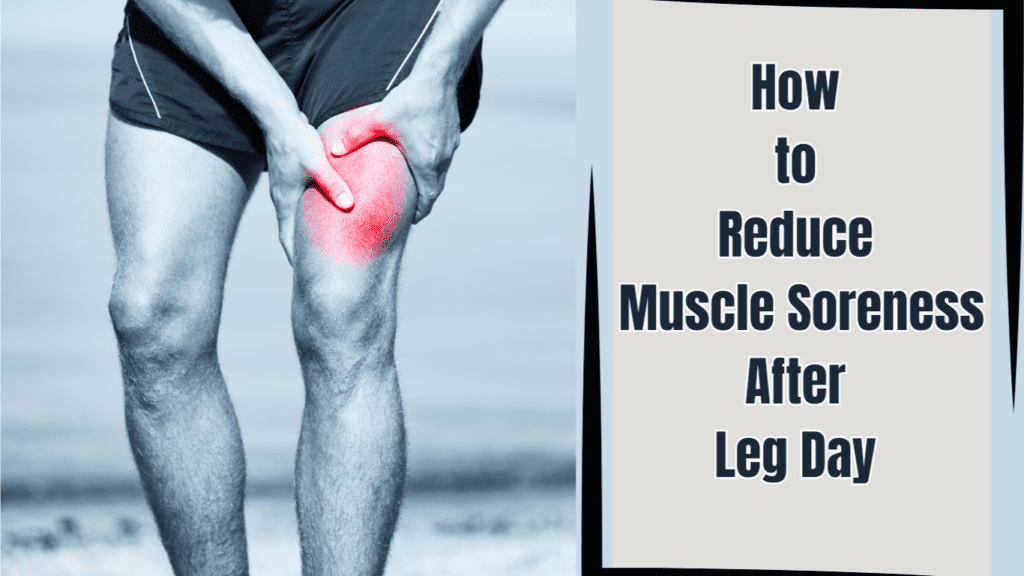
Leg day has a reputation, and for a good reason—it targets some of the biggest muscle groups in your body, including the quads, hamstrings, and glutes, all of which are put through the wringer during exercises like squats, lunges, and deadlifts. The result? Often, your legs are left screaming in protest. But why does leg day hurt more than other workouts? Simply put, the larger muscle groups mean more muscle fibers are being broken down, leading to greater soreness. It’s a necessary part of building strength and endurance, but that doesn’t mean you have to suffer endlessly.
So, how to reduce muscle soreness after leg day? That’s where we come in. The purpose of this article is to give you real, practical tips backed by science to help ease that soreness and speed up recovery time. While you can’t entirely prevent muscle soreness (and honestly, you wouldn’t want to—it’s a sign of progress), you can definitely minimize it and make the days after leg day far more manageable.
Subscribe And Get Our Free E-Book:Unlocking The Power Of Nutrition-Supplements, Substitutes, and Superfoods!
If you’re wondering how to reduce muscle soreness after leg day, it’s worth noting that no single method works perfectly for everyone, but there are tried and tested strategies that have been shown to help significantly. From proper warm-ups to targeted stretches, hydration, and even nutritional tweaks, we’ll be covering it all. Plus, we’ll also talk about some recovery methods that you might not have considered yet, like active recovery, foam rolling, and even the importance of sleep.
No matter where you are on your fitness journey, you’re bound to experience muscle soreness after leg day at some point. It’s a natural part of challenging your body and growing stronger. But knowing how to reduce muscle soreness after leg day can make a world of difference, not just in how quickly you recover but also in how consistent you can be with your workouts. After all, consistency is the key to long-term results, and no one wants to be sidelined by soreness for too long.
In this article, we’ll walk through everything you need to know about reducing muscle soreness and speeding up recovery so you can hit your next workout feeling fresher and stronger.
What Exactly Is DOMS?
DOMS, or Delayed Onset Muscle Soreness, is the soreness you feel 24 to 48 hours after a workout. It happens because of microscopic tears in your muscle fibers that occur when you push your body harder than usual or introduce new exercises into your routine. These tears are a natural part of building strength, as your muscles repair and grow stronger after being challenged. The process of breaking down and rebuilding muscle tissue is what leads to that sore, stiff feeling, but it’s also what helps you make gains in the long run. So, while DOMS can feel uncomfortable, it’s a sign that your workout was effective.
When it comes to how to reduce muscle soreness after leg day, it’s important to understand that DOMS is usually more pronounced when your muscles go through eccentric contractions. This means exercises that lengthen the muscle under tension, like lowering into a squat or controlling a deadlift on the way down. These types of movements put more stress on the muscle fibers, which is why DOMS is often worse after leg day.
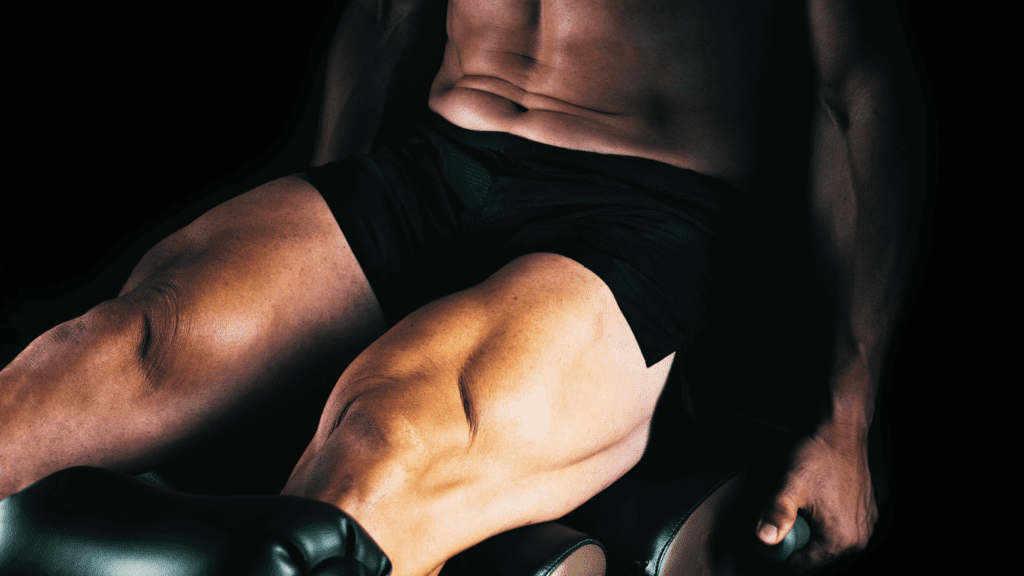
Why Leg Day Is So Notorious
Now, why does leg day hit so hard? Simply put, your leg muscles—particularly your quads, hamstrings, and glutes—are some of the largest muscle groups in your body. When you do exercises like squats, lunges, and deadlifts, you’re engaging these muscles in a big way. The more muscle you work, the more microscopic damage occurs, which leads to increased soreness.
Another factor that makes leg day infamous is the intensity of the exercises involved. Leg day often includes compound movements (like squats) that require multiple muscle groups to work together, leading to even more muscle engagement. The combination of high engagement and the large size of the muscles involved makes leg day soreness particularly intense.
On top of that, many leg day exercises emphasize eccentric movements, where your muscles lengthen under tension. For example, when you lower into a squat or lunge, your muscles are being stretched while also supporting your body weight. This stretching under tension causes more microtears in the muscle fibers, which means more DOMS. That’s why leg day tends to leave you walking a little funny for a couple of days afterward!
When Soreness Might Be a Sign of Something More
While DOMS is a normal part of muscle growth, it’s important to recognize the difference between normal soreness and excessive pain. Muscle soreness after leg day should feel like stiffness or a dull ache, and it typically improves with movement as your muscles warm up. However, if the soreness becomes sharp or unbearable, or if it lasts for more than a few days, it might be a sign of overtraining or even injury.
Signs you might be overdoing it include soreness that lingers for more than 72 hours, swelling, or bruising in the muscles. These could indicate muscle strain or injury rather than typical DOMS. In these cases, it’s essential to take a break, rest, and possibly consult a professional if the pain is severe.
Now that we’ve covered the basics of DOMS and why leg day can be particularly brutal, let’s talk about how to reduce muscle soreness after leg day. While some soreness is inevitable, there are practical steps you can take to ease the discomfort and speed up recovery. In the next section, we’ll dive into strategies that can help reduce soreness, from proper warm-ups and stretching routines to recovery techniques like foam rolling and hydration.
By understanding how muscle soreness works and why leg day tends to leave you feeling more sore than other workouts, you can better manage your recovery and get back to your routine faster. Learning how to reduce muscle soreness after leg day is all about balance—pushing yourself to improve while also giving your body the tools it needs to recover effectively.
Sore After Leg Day? 5 Critical Tips To Walk Normal Again Video
Effective Tips on How to Reduce Muscle Soreness After Leg Day
After an intense leg workout, it’s common to wonder how to reduce muscle soreness after leg day and speed up recovery. Sore muscles can make even simple tasks like walking or sitting uncomfortable. However, there are several effective strategies to minimize discomfort and get back to feeling your best. These tips cover everything from preparation before your workout to post-exercise recovery and beyond.
Warm-Up: Prime Your Muscles for Action
One of the best ways to reduce muscle soreness after leg day is to start your workout with a proper warm-up. Warming up increases blood flow to your muscles and prepares your joints for the movements they’ll go through during exercises like squats, lunges, and deadlifts. Without it, you’re more likely to experience greater muscle soreness.
Personalizing your warm-up based on your fitness level and the exercises you’ll be doing can make all the difference. A few key elements to include are:
- Dynamic Stretches: Movements such as leg swings, hip rotations, and walking lunges loosen up your joints and muscles. These dynamic exercises mimic the range of motion you’ll use during your workout, making them an ideal way to prepare.
- Mobility Drills: If you’re stiff in certain areas, like your hips or hamstrings, incorporating mobility drills like hip openers and foam rolling into your warm-up can ease restrictions and improve flexibility.
- Light Cardio: To get your muscles warm and ready for action, consider 5-10 minutes of light cardio such as brisk walking, cycling, or even jumping jacks. Raising your heart rate and increasing blood flow can significantly reduce your chances of muscle stiffness later.
Taking the time to warm up properly is key to how to reduce muscle soreness after leg day, as it primes your muscles for action and minimizes the strain that can lead to soreness.
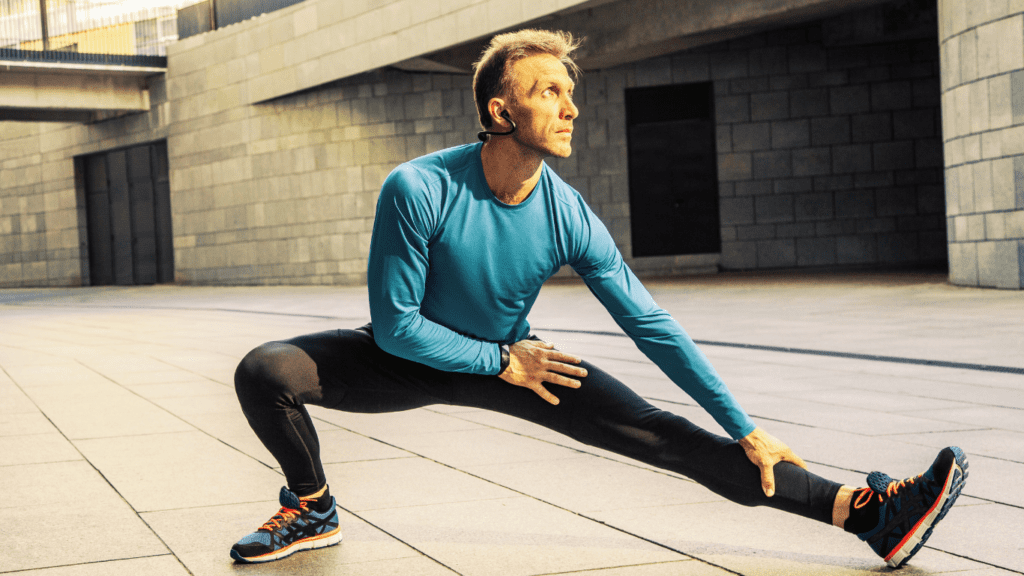
Cooldown and Stretch: Don’t Skip It!
While many people rush out of the gym after leg day, stretching right after your workout is a simple yet highly effective way to reduce muscle soreness after leg day. Stretching helps lengthen the muscles back out after they contract during your workout, which can relieve tension and improve flexibility.
After your leg workout, spend at least 5-10 minutes focusing on key muscle groups:
- Hamstrings: Seated or standing hamstring stretches help alleviate tightness in one of the largest muscle groups worked during leg day.
- Quads: The standing quad stretch is a simple but powerful move that targets the front of your thighs, which are often sore after exercises like squats and lunges.
- Glutes and Calves: Stretching your glutes with pigeon pose or downward-facing dog for your calves can also help ease the soreness that typically follows an intense leg workout.
This simple routine will help improve blood circulation to your muscles and prevent them from tightening up, which can reduce the intensity of soreness in the days following your workout.
Stay Hydrated
Staying properly hydrated is essential when considering how to reduce muscle soreness after leg day. Dehydration can increase the likelihood of cramping and stiffness, making muscle soreness worse. Water plays a critical role in flushing out toxins and byproducts from exercise, such as lactic acid, which contributes to soreness.
To stay hydrated:
- Drink water consistently throughout the day, especially before, during, and after your workout.
- If your leg day session was particularly sweaty, consider adding electrolytes to your water to replenish essential minerals lost through sweat.
Staying hydrated helps your muscles recover faster and minimizes the severity of post-workout soreness.
Fuel Up Properly: Nutrition’s Role in Recovery
The food you eat after your workout plays a major role in how quickly your muscles recover. To reduce muscle soreness after leg day, aim to eat a meal with the right balance of carbohydrates and protein. Carbs replenish glycogen stores in your muscles, while protein repairs the small tears in your muscle fibers caused by exercise.
Here are a few examples of balanced post-workout meals:
- A protein shake paired with a banana
- Chicken and rice, or any other lean protein paired with a complex carb
Incorporating anti-inflammatory foods like berries, leafy greens, and fish rich in omega-3s can also help reduce inflammation, further aiding in muscle recovery and reducing soreness.
Foam Rolling: Your Best Friend
If you’re still wondering how to reduce muscle soreness after leg day, foam rolling is an excellent solution. Foam rolling, or self-myofascial release, can help break up knots and increase blood flow to sore muscles, speeding up recovery.
To get the most out of foam rolling, focus on these key areas:
- Quads: Roll slowly from your hips to your knees, applying pressure to any tight spots.
- Hamstrings: Place the foam roller under your thighs and gently roll from the glutes to the knees.
- Glutes and IT bands: These areas can be particularly tight after leg day. Spend extra time rolling the outer side of your thighs and sitting muscles.
Foam rolling can be done both immediately after your workout and the next day when soreness begins to set in, helping to relieve discomfort and speed up recovery.
Active Recovery: Movement Helps, Not Rest
While the temptation may be to rest completely after an intense leg workout, light movement can actually be more effective in relieving soreness. Engaging in active recovery helps increase blood flow to your muscles, which promotes healing and reduces soreness.
Some great options for active recovery include:
- Walking: A gentle walk is perfect for getting your blood flowing without adding too much stress to your sore muscles.
- Yoga: Light stretching and flexibility exercises can improve your range of motion and reduce muscle tightness.
- Swimming or cycling: These low-impact exercises allow your muscles to stay active without overloading them.
Moving around, even when you’re sore, is an effective strategy when you’re looking for how to reduce muscle soreness after leg day.
Contrast Therapy: Hot and Cold Showers
Another method that can be helpful is contrast therapy, which involves alternating between hot and cold water. This technique is known to boost circulation and reduce inflammation, helping to relieve muscle soreness.
To try contrast therapy:
- Start with 30 seconds of cold water, followed by 1 minute of hot water, and repeat the cycle for about 10 minutes.
The combination of cold and hot water reduces inflammation and improves circulation, speeding up muscle recovery.
Supplements That May Help
If you want to further enhance your recovery process, certain supplements can support muscle repair. While not a substitute for proper nutrition, supplements like BCAAs, creatine, and magnesium have shown potential to help with muscle recovery. However, it’s important to remember that these should complement a healthy diet and exercise routine, not replace them.
Get Enough Sleep
Finally, sleep is one of the most important factors in reducing soreness and speeding up recovery. During deep sleep, your body repairs the damage done to muscles during your workout. Aim for 7-9 hours of quality sleep each night to allow your muscles to fully recover.
Creating a sleep-friendly environment by keeping your bedroom cool, dark, and quiet can help improve the quality of your sleep and reduce the amount of soreness you feel after leg day.
Chart: “Effectiveness of Post-Leg Day Recovery Techniques on Reducing Muscle Soreness”
| Recovery Technique | Level of Effectiveness on Soreness Reduction | Mechanism/Explanation |
|---|---|---|
| Active Recovery | ★★★★☆ (High) | Light movement, such as walking or yoga, increases blood flow to muscles, promoting healing and reducing stiffness. |
| Foam Rolling | ★★★★☆ (High) | Self-myofascial release helps break up muscle knots, increase circulation, and reduce tension, aiding in faster recovery. |
| Contrast Therapy (Hot/Cold) | ★★★☆☆ (Moderate) | Alternating hot and cold water boosts circulation and reduces inflammation, speeding up recovery. Cold reduces swelling, while heat improves blood flow. |
| Hydration | ★★★☆☆ (Moderate) | Staying hydrated flushes out exercise-related waste like lactic acid, reducing cramping and soreness. Water also supports muscle repair. |
| Protein and Carbohydrate Intake | ★★★★☆ (High) | Carbs replenish muscle glycogen, while protein aids in repairing muscle microtears. This nutrient combination is essential for recovery. |
| Sleep (7–9 Hours) | ★★★★★ (Very High) | Deep sleep triggers hormone release (e.g., growth hormone) that promotes muscle repair and reduces soreness. This is one of the most effective recovery methods. |
| Dynamic Warm-Up | ★★★★☆ (High) | Increases blood flow and muscle temperature before exercise, preparing muscles and joints for activity and lowering post-workout soreness. |
| Static Stretching | ★★★☆☆ (Moderate) | Stretching lengthens muscles post-workout, relieving tension and enhancing flexibility, which can reduce muscle tightness and soreness. |
| Supplements (e.g., BCAAs, Creatine) | ★★★☆☆ (Moderate) | Branched-chain amino acids (BCAAs) and creatine support muscle repair and reduce soreness by aiding muscle protein synthesis and energy replenishment. |
Explanation of Effectiveness Levels:
- Very High: Consistently shown to be highly effective in multiple studies.
- High: Often reduces soreness, backed by strong evidence or widely recommended.
- Moderate: May alleviate soreness; effectiveness varies by individual.
Incorporating these practical tips will give you a comprehensive approach on how to reduce muscle soreness after leg day. Whether it’s through proper warm-ups, staying hydrated, or ensuring you get enough rest, each strategy plays a crucial role in minimizing discomfort and improving your overall recovery time.
Key Mistakes to Avoid When Learning How to Reduce Muscle Soreness After Leg Day
You know you’ve had a great leg day when walking down the stairs feels like a scene from a slow-motion action movie. But before you settle into the comfort of your couch, let’s talk about some crucial mistakes to avoid if you’re wondering how to reduce muscle soreness after leg day. Making the right choices after an intense workout can significantly impact your recovery.
Avoid Sitting Too Long
After leg day, it’s tempting to plop down on the couch and let your legs rest, but prolonged sitting can actually worsen muscle tightness and soreness. When you sit for long periods, blood circulation decreases, leading to stiffer muscles. This tightness can make it even harder to move the next time you need to get up, essentially creating a cycle of discomfort.
In addition, extended periods of inactivity can slow down the recovery process. When your muscles are tight, they lose flexibility and may take longer to recover from the stress of your workout. So, while it might feel good to kick back and relax, it’s important to get up and move around every so often.
To help mitigate this, aim to take a break every hour. Stand up, stretch, or take a short walk around your house or office. Simple activities like these can promote blood flow and prevent your muscles from tightening up further, making it easier to manage soreness. Remember, staying active is one of the best strategies when considering how to reduce muscle soreness after leg day.

Don’t Rush Back to Heavy Lifting
It can be tempting to hit the gym again the day after leg day, especially if you’re eager to maintain your momentum. However, if your muscles are still sore, it’s vital not to rush back into heavy lifting. Pushing yourself too hard before your body has fully recovered can lead to overtraining, which not only increases the risk of injury but can also hamper your long-term progress.
Muscle soreness is a natural part of the recovery process. It signifies that your muscles are adapting to the stress of your workouts and rebuilding stronger. However, if you ignore soreness and jump back into high-intensity workouts too quickly, you could actually set yourself back instead of moving forward.
Instead, focus on lighter workouts or other muscle groups. If you feel ready to exercise, consider engaging in low-impact activities such as swimming, cycling, or yoga. These alternatives allow your legs to recover while keeping you active, striking a balance between rest and continued movement. This approach is essential when you’re trying to figure out how to reduce muscle soreness after leg day and ensure you are nurturing your body properly.
No Excessive Painkillers
When muscle soreness strikes, it’s easy to reach for over-the-counter pain relievers like ibuprofen. While these medications can offer short-term relief, relying on them excessively can blunt your body’s natural recovery process in the long run. Studies have shown that using nonsteroidal anti-inflammatory drugs (NSAIDs) too often can interfere with muscle adaptation and growth. Essentially, you might be numbing the pain but also hindering your body’s ability to heal effectively.
Instead of relying on painkillers, consider other ways to manage discomfort naturally. Gentle movement, stretching, and techniques like foam rolling can help ease muscle tightness and promote blood flow, which are crucial for recovery. Listening to your body is essential, and if the soreness is mild, you may find that light activity alleviates discomfort more effectively than any medication.
Moreover, consider natural anti-inflammatory options, such as incorporating more omega-3 fatty acids into your diet. Foods like fatty fish, walnuts, and flaxseeds have properties that can help reduce inflammation. This way, you can address soreness without interfering with your body’s natural healing mechanisms, allowing you to learn more about how to reduce muscle soreness after leg day effectively.
Chart: Avoid These Mistakes After Leg Day and Try These Instead
| Mistake | Why It’s a Problem | Try This Instead |
|---|---|---|
| Sitting Too Long | Limits blood flow, causing stiffness. | Move Often: Stand up and stretch hourly. |
| Lifting Too Soon | Overtraining risks injury and delays recovery. | Active Recovery: Do light activity like yoga. |
| Overusing Painkillers | Slows natural muscle recovery. | Use Natural Relief: Foam roll, stretch, or try omega-3-rich foods. |
| Ignoring Pain | Persistent pain may signal injury. | Listen to Your Body: Rest if needed; see a doctor for sharp pain. |
| Skipping Nutrition | Delays muscle repair. | Refuel: Have protein and carbs post-workout. |
| Not Drinking Enough | Dehydration slows recovery. | Stay Hydrated: Drink water, especially after exercise. |
Being mindful of what not to do after leg day is just as important as knowing what actions to take. By avoiding long periods of sitting, resisting the urge to lift heavy too soon, and not over-relying on painkillers, you’ll set yourself up for a smoother recovery. Remember, taking the right steps after leg day can significantly enhance your overall progress and well-being, making your next workout more enjoyable and productive.
Signs It’s More Than Just Soreness
You know that feeling when your legs are so sore you wonder if you accidentally joined a competitive leg press contest? While muscle soreness is a common result of a tough leg day, it’s essential to know when that soreness might indicate something more serious. Understanding the difference between normal soreness and signs of injury or overtraining can significantly help you in your quest to learn how to reduce muscle soreness after leg day.
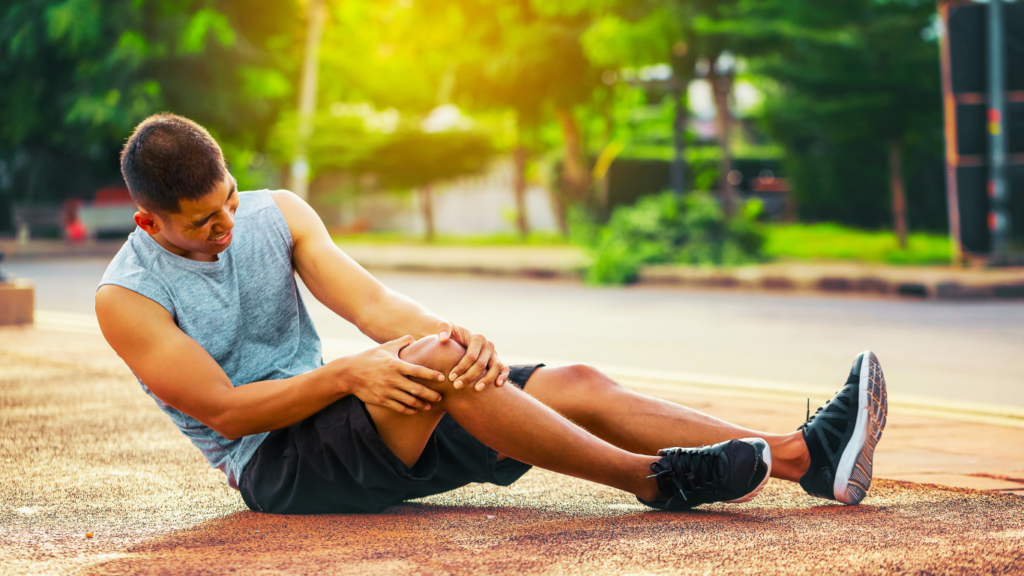
Normal Soreness vs. Injury Symptoms
Delayed Onset Muscle Soreness (DOMS) is a typical response to the strain of exercise, especially after engaging in new or intense workouts. This kind of soreness usually sets in 24 to 48 hours post-exercise and can last up to several days. It manifests as a dull, achy feeling in the muscles and is often accompanied by stiffness.
However, there are clear indicators that suggest your soreness might be something more than just the regular discomfort of a good workout. Here’s what to look out for:
- Sharp or Persistent Pain: If you feel a sharp, shooting pain that doesn’t fade or worsens with movement, this could indicate an injury. Normal soreness should gradually decrease over time, while sharp pain may signify a strain or tear in the muscle.
- Swelling or Bruising: While some minor swelling can occur after an intense workout, significant swelling, particularly if it is accompanied by bruising, may be a red flag. If you notice swelling that is not normal for soreness, it could be a sign of a more serious issue that needs attention.
- Reduced Range of Motion: If you find it challenging to move your legs or perform normal activities, this can signal that something is wrong. Normal soreness shouldn’t restrict your range of motion significantly.
- Weakness: Experiencing noticeable weakness in the affected area that persists even when you’re not working out can indicate that the muscle is injured. Soreness should not impact your ability to use the muscle effectively in daily activities.
Recognizing these signs is crucial not only for your recovery but also for ensuring you stay on track with your fitness journey. It can help you better understand how to reduce muscle soreness after leg day by taking proactive steps to care for your body.
When to Seek Professional Help
If you suspect that your soreness is more than just typical post-workout discomfort, it’s crucial to consult a professional. Seeking advice from a doctor or physiotherapist can provide clarity and ensure that you receive the right treatment. They can help assess your condition, provide appropriate exercises, and offer rehabilitation options to speed up your recovery.
Don’t hesitate to reach out if you experience any of the warning signs mentioned above. Ignoring them could lead to more severe injuries or chronic issues down the line. Being proactive is essential when trying to learn how to reduce muscle soreness after leg day and maintain your overall health and well-being.
Emphasizing Recovery and Self-Care
Understanding how to differentiate between normal soreness and potential injuries is a vital part of any fitness routine. Recognizing your body’s signals can help you make informed decisions about your training regimen. Prioritizing recovery and self-care ensures that you can continue progressing toward your fitness goals without putting yourself at risk.
Incorporating adequate rest, nutrition, hydration, and low-impact exercises into your routine is crucial. These practices can help your body heal and minimize the chances of experiencing injuries. Taking the time to listen to your body will ultimately enhance your performance and help you learn how to reduce muscle soreness after leg day effectively.
While leg day can leave you with some serious soreness, knowing the difference between normal discomfort and potential injury can keep you on the right track. By being aware of the warning signs and seeking professional advice when necessary, you can ensure a safe and effective fitness journey. Your body will thank you for it, allowing you to hit your next leg day with confidence!
Final Insights on How to Reduce Muscle Soreness After Leg Day
As you wrap up your intense leg day, you may find yourself wondering about the best ways to deal with the inevitable soreness that follows. You might even be contemplating the delicate dance between pushing your limits and ensuring proper recovery. Understanding how to reduce muscle soreness after leg day is crucial for every fitness enthusiast, whether you’re a seasoned lifter or just starting your journey.
Throughout this article, we’ve explored several key strategies for managing muscle soreness, allowing you to enjoy your workouts while keeping discomfort in check. Here’s a concise summary of the main points discussed:
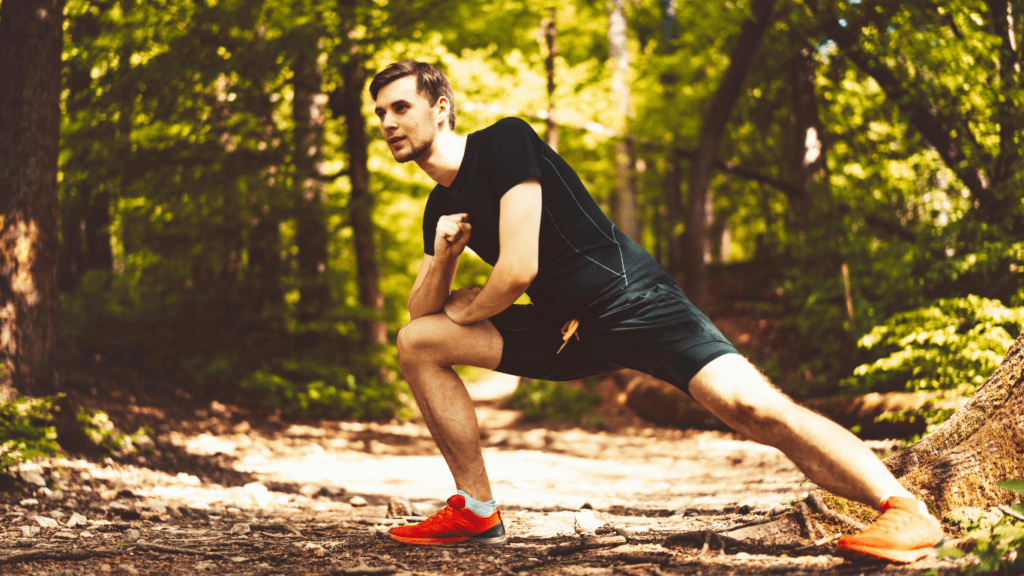
- Warm-Up Properly: Engaging in a solid warm-up routine prepares your muscles for the intensity of leg day, helping to prevent injuries and soreness.
- Cooldown and Stretch: Taking the time to stretch after your workout can significantly reduce muscle tension and promote flexibility.
- Stay Hydrated: Proper hydration is essential for muscle recovery. Drinking water helps flush out toxins and supports overall muscle function.
- Fuel Your Body: Consuming a balanced post-workout meal rich in protein and carbohydrates is vital for muscle repair and energy replenishment.
- Foam Rolling: Utilizing foam rollers can help release tight muscles, improving blood flow and reducing soreness.
- Active Recovery: Engaging in light activity, such as walking or yoga, can help alleviate soreness by promoting circulation.
- Know What NOT to Do: Avoid prolonged sitting, rushing back into heavy lifting, and relying excessively on painkillers. Recognizing the signs of serious injury is equally important.
By incorporating these strategies into your fitness routine, you will not only learn how to reduce muscle soreness after leg day but also enhance your overall workout experience. Remember, while muscle soreness can be uncomfortable, it’s a normal part of the process of getting stronger. Embrace recovery as an essential component of your fitness journey rather than just something to endure.
With the right recovery strategies in place, you’ll not only minimize muscle soreness but also improve your performance in future leg workouts. A well-rounded approach to fitness includes paying attention to how your body feels, ensuring you recover adequately, and listening to its needs. This will lead you to long-lasting results and a more enjoyable workout experience.
Frequently Asked Questions
- What causes muscle soreness after leg day?
- Muscle soreness, often referred to as DOMS (Delayed Onset Muscle Soreness), occurs due to microscopic tears in muscle fibers following intense exercise, particularly when new exercises are introduced or when weights are increased.
- How long does muscle soreness usually last?
- Muscle soreness typically peaks around 24 to 72 hours post-workout and can last several days, depending on the intensity of the exercise and individual recovery processes.
- Is it normal to experience muscle soreness every time I work out?
- It’s common to experience soreness after intense workouts, especially when trying new exercises. However, regular soreness shouldn’t be excessive; if it is, you may need to adjust your workout intensity.
- Can I work out if I’m still sore?
- Yes, light exercise or active recovery can help alleviate soreness. However, avoid high-intensity workouts that stress the sore muscles until they feel better.
- What are some effective stretches for leg day soreness?
- Effective stretches include hamstring stretches, quad stretches, calf stretches, and hip flexor stretches, which can help improve flexibility and reduce tension.
- Does hydration affect muscle soreness?
- Absolutely! Staying hydrated helps flush out toxins from your muscles and supports their recovery, reducing the severity of soreness.
- Can foam rolling really help reduce soreness?
- Yes, foam rolling helps break up tight muscle knots and increases blood flow to the area, promoting quicker recovery and reducing soreness.
- How does nutrition play a role in muscle recovery?
- Proper nutrition, particularly a post-workout meal rich in protein and carbohydrates, is essential for repairing muscle tissue and replenishing glycogen stores.
- What signs should I look for that indicate an injury?
- Look for sharp or persistent pain, swelling, bruising, and a significant reduction in your range of motion as signs that you may have an injury.
- When should I consult a professional about my soreness?
- Consult a professional if your soreness feels abnormal, lasts too long, or is accompanied by severe pain, swelling, or any other unusual symptoms.
Thank you for joining us on this journey toward understanding how to reduce muscle soreness after leg day. We encourage you to share your thoughts and experiences in the comments section below, and don’t forget to subscribe for more tips on your fitness journey! Happy lifting!


